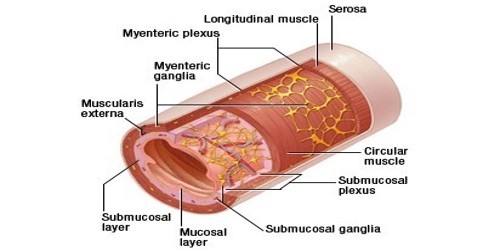The enteric nervous system (ENS) is a part of the peripheral nervous system. It controls the reflexes of the gastrointestinal system. It along with the sympathetic and parasympathetic nervous systems, constitute the autonomic nervous system. It appears to modulate intestinal secretion. It is a component of the neural control systems for the digestive organs.
Some treat the ENS as part of the autonomic nervous system. It contains full reflex circuits for control of intestinal motility, fluid transport, blood flow, and nutrient handling. The principal components of the enteric nervous system are two networks or plexuses of neurons, both of which are embedded in the wall of the digestive tract and extend from esophagus to anus:
- The myenteric plexus is located between the longitudinal and circular layers of muscle in the tunica muscularis and, appropriately, exerts control primarily over digestive tract motility.
- The submucous plexus, as its name implies, is buried in the submucosa. Its principal role is in sensing the environment within the lumen, regulating gastrointestinal blood flow and controlling epithelial cell function.
It controls these functions in concert with integrating centers in the lower brain stem, sympathetic ganglia, and the spinal cord. It is composed of neurons and glia that modulate many aspects of intestinal function.
















